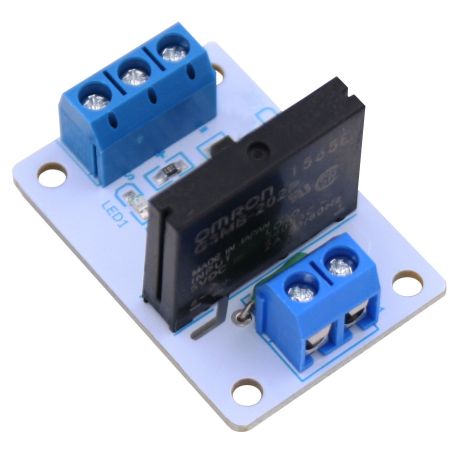Static relay module - 240V 2A
Static relay module 240V AC / 2A
Secure payments
Payments are secured by LyraCollect, a French payment collection company.
Payments are secured by LyraCollect, a French payment collection company.
Multiple delivery solutions
It is possible to delivered to your home, to a pick-up point or picked up by appointment at MCHobby
It is possible to delivered to your home, to a pick-up point or picked up by appointment at MCHobby
Parcels packed with care and efficiency
We prepare, pack and ship your orders with great respect and care.
We prepare, pack and ship your orders with great respect and care.
Static relay module to power-up your loads
Static relay are made with several electronic components including semi-conductor.
Very similar to usual relay, the static relay offer two connections to contrrol the relay (control logic) and several terminals to connect the load (high power circuit).
The command circuitery usually includes an opto-coupler to have a galvanic isolation between high power circuit and microcontroler (this product does not include an opto-coupler).
The power circuitery is made of electronic power component able to control a high current flow.
Static relay advantages
- Lifetime and reliability is around several millions cycles. Mechanical relay have +100.000 life cycle.
- Very silent.
- No EMI disturb as it exists for the mecanical relay (contact bouncing creating EMI) .
- Support higher commutation frequency compared to mechanical relay. Static relay is well suited for simple on/off regulation (ex: oven using heating resistor, food oven, coffee machine, thermoforming, etc).
Static relay cons
- Satic relay are more expansive than mechanical relay.
- Higher current (too higher) will degrade the semi-conductor up to its desctruction (flashed). The relay stays open (sometime), either a marginal current still flow into it (rare), either the short-circuit appears toward the control interface (rare), either the contact stays close (often).
- The internal resitor is not zeroed. So the semi-conductor generate heat (joule effect). Electrocal loose are higher than mechnaical relay.
For high power load, user should use heatsink and forced air. - It is not possible to have normaly close with static relay.
So, you cannot use static relay in application requiring normaly close contact at startup (when there is no power). - The static relay does not offer galvanic isolation as the current is controled through a semi-conductor. As a consequence, there is always a current flowing through the semi-conductor (few milli-amps, it is negligible except for human body). To work on the circuit you must cut the power supply with a breaker. An opto-coupler should be place in the control circuit to ensure a galvanic isolation between power stage and control stage.
Technical details
- Supply: 5V DC
- Max current: 10mA
- Relay ON: for input voltage from 0 to 2.5V DC
- Relay OFF: for input voltage from 3.3 to 5V DC
- Fuse: 2A, pico fuse
MODULE-RELAIS-STATIC
3232100015685







